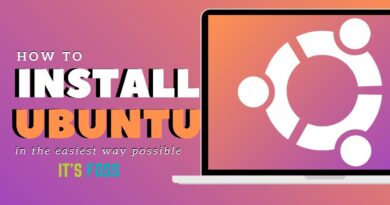Linux Tutorial For Beginners | Part 2 | Linux File System Layout
Linux (/ˈlinʊks/ (About this soundlisten) LEEN-uuks or /ˈlɪnʊks/ LIN-uuks[9]) is a family of open-source Unix-like operating systems based on the Linux kernel,[10] an operating system kernel first released on September 17, 1991, by Linus Torvalds.[11][12][13] Linux is typically packaged in a Linux distribution.
Distributions include the Linux kernel and supporting system software and libraries, many of which are provided by the GNU Project. Many Linux distributions use the word “Linux” in their name, but the Free Software Foundation uses the name GNU/Linux to emphasize the importance of GNU software, causing some controversy.[14][15]
Popular Linux distributions[16][17][18] include Debian, Fedora, and Ubuntu. Commercial distributions include Red Hat Enterprise Linux and SUSE Linux Enterprise Server. Desktop Linux distributions include a windowing system such as X11 or Wayland, and a desktop environment such as GNOME or KDE Plasma. Distributions intended for servers may omit graphics altogether, or include a solution stack such as LAMP. Because Linux is freely redistributable, anyone may create a distribution for any purpose.[19]
Linux was originally developed for personal computers based on the Intel x86 architecture, but has since been ported to more platforms than any other operating system.[20] Because of the dominance of Android on smartphones, Linux also has the largest installed base of all general-purpose operating systems.[21][22][23] Although it is used by only around 2.3 percent of desktop computers,[24][25] the Chromebook, which runs the Linux kernel-based Chrome OS, dominates the US K–12 education market and represents nearly 20 percent of sub-$300 notebook sales in the US.[26] Linux is the leading operating system on servers (over 96.4% of the top 1 million web servers’ operating systems are Linux),[27] leads other big iron systems such as mainframe computers, and is the only OS used on TOP500 supercomputers (since November 2017, having gradually eliminated all competitors).[28][29][30]
Linux also runs on embedded systems, i.e. devices whose operating system is typically built into the firmware and is highly tailored to the system. This includes routers, automation controls, smart home technology (like Google Nest),[31] televisions (Samsung and LG Smart TVs use Tizen and WebOS, respectively),[32][33][34] automobiles (for example, Tesla, Audi, Mercedes-Benz, Hyundai, and Toyota all rely on Linux),[35] digital video recorders, video game consoles, and smartwatches.[36] The Falcon 9’s and the Dragon 2’s avionics use a customized version of Linux.[37]
Linux is one of the most prominent examples of free and open-source software collaboration. The source code may be used, modified and distributed commercially or non-commercially by anyone under the terms of its respective licenses, such as the GNU General Public License.[19]
90% of all cloud infrastructure is powered by Linux including supercomputers and cloud providers.[38] 74% of smartphones in the world are Linux-based.[39]
Many open source developers agree that the Linux kernel was not designed but rather evolved through natural selection. Torvalds considers that although the design of Unix served as a scaffolding, “Linux grew with a lot of mutations – and because the mutations were less than random, they were faster and more directed than alpha-particles in DNA.” [66] Raymond considers Linux’s revolutionary aspects to be social, not technical: before Linux complex software was designed carefully by small groups, but “Linux evolved in a completely different way. From nearly the beginning, it was rather casually hacked on by huge numbers of volunteers coordinating only through the Internet. Quality was maintained not by rigid standards or autocracy but by the naively simple strategy of releasing every week and getting feedback from hundreds of users within days, creating a sort of rapid Darwinian selection on the mutations introduced by developers.”[67] Bryan Cantrill, an engineer of a competing OS, agrees that “Linux wasn’t designed, it evolved”, but considers this to be a limitation, proposing that some features, especially those related to security,[68] cannot be evolved into, “this is not a biological system at the end of the day, it’s a software system.” [69] A Linux-based system is a modular Unix-like operating system, deriving much of its basic design from principles established in Unix during the 1970s and 1980s. Such a system uses a monolithic kernel, the Linux kernel, which handles process control, networking, access to the peripherals, and file systems. Device drivers are either integrated directly with the kernel, or added as modules that are loaded while the system is running.
Namaskaar Dosto, is video mein maine aapse Linux ke baare mein baat ki hai. Linux kya hai? Linux aur windows mein kya difference hai? aur Linux ke kya advantages aur disadvantages hai. Mujhe umeed hai ki aapko Linux ke baare mein yeh video pasand aayega.
by Shailendra Srivastava
linux foundation



